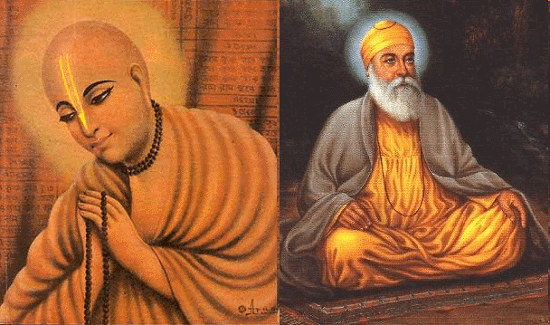
"A contemporary of Mahaprabhu, Guru Nanak was older to Mahaprabhu by 16 years. He departed five years after the disappearance of Chaitanya Mahaprabhu. Nanak sought a religious path that avoided the formal structures of both Islam and Hinduism. However, in the Guru Granth Sahib, there are frequent references to Har Krishen, Gobind, Gopal and Ram.
Thus most of the names for God in Gurbani come directly from Vaishnava bhakti school. Clearly, Nanak dev ji believed in a God that was both formless and full of form. Nirgun as well as Sagun. One does not negate the other. Both coexist at the same time, resonating with Sri Chaitanya’s philosophy of ‘Achintya Bhed Abhed’ (inconceivable unity in duality).
In 1506 Nanak visited seven regions across India. He lived for 71 years and within his life time he is believed to have spent 25 years travelling all over the country from Himalaya to Cape Comorin.
He also visited Mecca and Madina, Turkey and China. It has been estimated that he had walked about 50,000 miles on foot with wooden sandals. He also converted Raja Seonath, the king of Ceylon to his own religion. Before proceeding towards Ceylon he visited Orissa.
Legend says that Guru Nanak arrived at Puri with his disciple 'Mardana', a Muslim follower. When Guru Nanak reached Puri beach in the evening near the present Swargadwar, he sat down in meditation.
Mardana was hungry but as he was a Muslim he was not allowed to enter the Jagannath temple for Mahaprasad. So the disciple blamed Nanak for selecting such a place where they had to face starvation.
Suddenly at that time somebody appeared and offered food and drink in golden utensils. In the early hours of morning however there was a commotion in the Jagannath temple because the gold utensils of the Lord were missing.
The news was conveyed to the Maharaja of Puri. Guru Nanak appeared to the Raja in his dream that night. So when the Raja heard about the theft, he smiled and marched towards sea-beach in a procession to welcome the saint.
The Raja found the saint in meditation and the gold utensils were lying close by. Then the king and his party gave a hearty reception to the saint who had come to Puri to pay his homage to Lord Jagannath.
Nanak was invited to visit the temple at the time of arati in the evening. When the arati started, Guru Nanak stood silent, not participating. Later when asked why, he said, this was not homage enough to the glory and wonder of the Lord of the Universe, to whom Nature paid a far more sublime tribute. In reply, he sang verses which remain immortal for their exquisite mystic poetry:
“In the salver of the sky The Sun and Moon shine like lamps,
The galaxy of stars are scattered like pearls;
The chandan-scented winds waft as Thine incense,
The forests are Thy flowers.
(Thus) is Thy arati performed,
O, Thou Destroyer of fear!”
Once when his disciples were thirsty but had no water to drink, he requested them to dig a hole in the sandy surface of sea-beach and to their surprise sweet water came out. A well was constructed around this hole. Near that well a Gurudwara called Bauli Saheb came into existence. This is now called 'Baulimath'. This is a sacred place of pilgrimage for the Sikhs.
Chaitanya Mahaprabhu and Guru Nanak both met at Puri and spent some time there. This incident is recorded in Chaitanya Bhagavat of Iswar Das, written in Oriya in 17th Century.
The author, Ishvar Das, was one of Mahaprabhu’s close associates in Puri, and the only biographer to mention the event, perhaps because the meeting was brief and only the eyewitness devotees of Puri knew about it.
Ishvar Das writes: (Ishvar Das’s Chaitanya Bhagavat, Adhyaya 61).
Srinibasaye Viswambhara
Kirtan madyare vihar
Nanak Saranga ye dui
Rupa Sanatana duibhai
Jagai Madhai ekatra
Kirtan Karanti Nritya
“In the congregational singing led by Shri Chaitanya in Nagar Purushottama (Puri dham), Nanak and Saranga (another name for Mardana who played the sarangi), the two bothers Rupa and Sanatana along with Jagai and Madhai also joined in. Gopal Guru, for whom Guru Nanak had deep affection, was there as well, along with Nityananda Prabhu, who was considered an incarnation of Balarama. They all relished the kirtan at Jagannath Puri.”
(Ishvar Das’s Chaitanya Bhagavat Adhyaya 64).
A popular legend is told of how Guru Nanak was entering the temple of Lord Jagannath, he met Sri Chaitanya Mahaprabhu who was coming out. Both offered pranamsto each other. Then Nanak turned and started to leave the temple. Mahaprabhu asked him why he was not going inside to have darshan. Guru Nanak replied ‘I have already seen the Lord’.
According to Padmabhushan Dr. Durgadas Basu, a National Research Professor, Guru Nanak was given mantra diksha by none other than Prabhu Nityananda while the latter was traveling through Bangladesh (Bengal). That Sri Nanak was a ‘mantra shishya’ of Nityananda Prabhu has been written down in his autobiography and the last chapter of the Guru Grantha Sahib, while elaborating the greatness and glory of the holy ‘Naam’.
In the Granth Sahib, it is written:
“Swasi grasi harinam samali
Simar bus vishwambhar ak”
"In order to attain salvation, one must chant the holy name of Ram, Hari or Vishwambhar."
Compiled by

